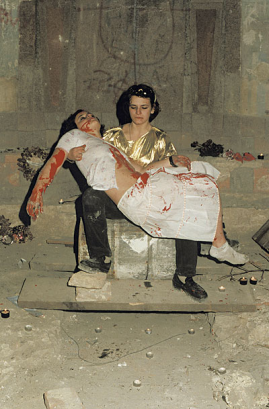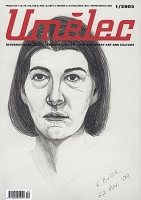| Zeitschrift Umělec 2005/1 >> Piva Harley and Aurora Davidson 1994–96 | Übersicht aller Ausgaben | ||||||||||||
|
|||||||||||||
Piva Harley and Aurora Davidson 1994–96Zeitschrift Umělec 2005/101.01.2005 Lenka Klodová | vorgestellt | en cs |
|||||||||||||
|
Piva and Aurora came about during the entrance exams of two girls, Klára Froňková and Ivana Junková, who fell in love and decided that they’d either both be admitted or neither would be. They were not lesbians but heterosexuals, and they went for boys. When Klára went away to Holland, Iva was lost. Then Iva had a child and Klára got pregnant in Holland at the same time. That was the end of Piva and Aurora. It happened with the appearance of someone—someone was born, somebody needed to be taken care of, someone broke the tightness of the two—a hole was opened up and the energy generated by the two rebelling girls spilled out.
Piva and Aurora were previously two peas in a pod. They created an energetic unit whose core was carried by neither of them, but was somewhere between, in the middle of their embrace. Klára tended towards serious depressions; Iva was more motherly, but that’s unimportant. They launched into optimistic projects: Life and Art Are One, The World of Drunkards is Great, and Piva and Aurora Like Each Other. There was Get the Fuck Out! in the positive sense (“go out on the street, close the door behind you and get the fuck away from everything, from people, apartments, and the furniture in those apartments”), where “the finger,” dark circles under your eyes and vomit get mixed together with “I love you, I love myself, you are beautiful, I am beautiful.” Their space and exhibitions concerned their attempt to create a home for themselves. First each for herself: Piva made a sharp red tent with lights inside, covered with a plastic membrane; Aurora made a brick house, an illustration right out of Little Red Riding Hood, dedicated to the actor, Jan Tříska. Their work together was a white polystyrene box in a construction of spruce wood with the bark peeled off; for the uninvited there was one single opening, taped. There was nothing unexpected within: a mixture of cuddly toys, pornographic pictures, clothes, plastics, and aprons giving birth to dolls all sprayed with loud colors and illuminated by a stroboscope. The intimacy of the cube is a limitation of their own world and also an expression of an insecurity and mistrust towards the institution of art and art school. If you don’t like it, we’ll seal up the last opening. The cube – making sure that it was considered art – opened up at their solo exhibition in the Macromolecular Institute in Prague - Petřiny in the winter of 1996. The walls of the exhibition corridor are covered with multicolored graffiti-sprayed polystyrene panels, construction elements that you can see are parts of a deconstructed building. On the outer side we can see the inside of skin, sprayed with messages meant for themselves only. These were accompanied with a series of paintings on colored paper – records, letters, vision, utopias. The beneficial influence of rebellious outrageousness is up front and center in Piva & Aurora’s drawings. These somewhat naive, decorative and immature drawings are grasped within its harsh content as a material and moved into a unified concept of the phenomena of Piva & Aurora: we have no time to practice this the right way, to train our hand; we are in a hurry, we’ve got to do it now before it’s too late. The drawing To je to, o čem jsme (This Is What We Are About) is a picture with memories of the 8th grade – two girls in a kitchen: “Clink clink! We are finishing making the third child, dear friends.” Girlish rebellion should be colorful and beautiful. It has long been very difficult to find some form of disobedience that has no advertisement aesthetics. It can’t be helped: we still want to be rock stars shouting nasty lyrics into colored lights on stage while crowds dance writhing. Of course the girls couldn’t miss out on the art form of a photographic series. They have sets of fashion photographs in which they pose dressed up in baby clothes; They also have a more artificial action, performance that simulates or perhaps doesn’t simulate an event from real life. Their first project Obydlí (Dwelling) – a red tent and a brick house – was accompanied by an action Hledáme místo pro dům (We Are Looking for a Place for a House). Two girls are on the way from their home in the region of Hořice, and passing through a late-winter landscape they look for a place for their house with the help of alcohol. In an orchard, drunk, they built the groundfloor plan of their house out of someone’s bricks and stones. The action Konec 95 (End 95) was photographed at the occasion of a farewell party from their college dorm room – they were thrown out on the grounds of vandalism. After being thrown out of the first and then the second residence hall they were forbidden any accommodation in all of Prague. The action shows them trying to put the room “into its original state” with the best intentions: they whitewashed the walls, the radiator, garbage can and part of the mirror painted pink. Piva & Aurora work – and that is the main appeal of their work – blurring the borders between real life experience and a work of art. During their existence they were never “civil”, they constantly lived in their art form, in a thought-out and reflected mixture of authenticity and stylization. The exhibited photos from the actions are hung slapdash, in the most common format 9x13 cm, but at the same time they all are clearly and sharply communicative, with a transparent composition although adjusted with scissors. Piva & Aurora worked in 1995 with forms that are now popular – photo series, project drawings, diary records, and installationsr. The most interesting contemporary art projects process in this way different social phenomena – minority communities, homeless people, and prostitutes. Piva & Aurora defined themselves within those two years – they created a multi-media statement about the ups and downs of two girls studying at the same school, about a girls’ friendship—a relationship that at this age is not usual. The project was free of too much stylization which should hide the still post-pubescent esthetics, being subjected to the attractions of drugs or your own body, the surplus physical energy that brings you through back streets ultimately leading towards reproduction anyway. I can imagine that if they could go on in this way, if they would try to stop anyone getting in between them, they could become professional friends. Just as Orlan wears her implants her whole life, the Piva & Aurora project would forever have an effectiveness of an art monument of the extent of personal sacrifice. The theme would not be the “trivial” problem of coping with the fashion industry, but something important like human friendship. The ability of the body to tolerate a piece of plastic is nothing compared to the effort of living with another person. Perhaps they can explain how adult women manage rebellion when they no longer look so great in ragged trendy pants. The concluding collective work by Piva & Aurora is Pieta, created as part of the Tělo a místo (Body and Place) program led by Barbara Benish at the Academy of Arts, Architecture and Design in 1996. The blood-covered body of Piva lies on Aurora’s lap in the position of Michelangelo’s Pieta, in the partially abandoned ruins of the Šlechtovka restaurant in Prague’s Stromovka park.
01.01.2005
Empfohlene Artikel
|
|||||||||||||








Kommentar
Der Artikel ist bisher nicht kommentiert wordenNeuen Kommentar einfügen